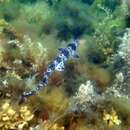Diagnostic Description
provided by FAO species catalogs
fieldmarks: Inconspicuous dusky collar around the gills, with or without three or four dark spots; six or seven dusky saddles on back and tail; moderately sparse to dense, large to small dark brown or blackish spots on body, tail and fins, more than six dark spots on the sides of the tail between the dorsal fins; nasal barbels, nasoral and circumnarial grooves present, mouth in front of eyes; two equal-sized, spineless dorsal fins and an anal fin, the first dorsal-fin origin behind the pelvic-fin bases, the anal-fin origin well in front of the second dorsal-fin origin. Grey-brown with six dusky saddles on trunk, tail and caudal fin; an indistinct dark, collar marking around gill region, unspotted or with up to three or four dark spots; no white spots on body; no bold large black blotches on fins though unpaired fins usually have small to large rounded black spots on them; moderately sparse to dense, scattered, large dark brown spots on body and fins, three or four (mainland) to five or six (Tasmania) irregular longitudinal rows of dark spots on sides, and more than six spots on the sides of the tail between the dorsal fins.
Scott, 1961
- bibliographic citation
- Sharks of the world An annotated and illustrated catalogue of shark species known to date. Volume 2 Bullhead, mackerel and carpet sharks (Heterodontiformes, Lamniformes and Orectolobiformes). Leonard J.V. Compagno 2001. FAO Species Catalogue for Fishery Purposes. No. 1, Vol. 2. Rome, FAO. 2001. p.269.
- author
- Food and Agriculture Organization of the UN
Distribution
provided by FAO species catalogs
Western South Pacific: Confined to the south and east coasts of Australia (Western Australia, South Australia, Victoria, from Albany to Gabo Island, and Tasmania).
- bibliographic citation
- Sharks of the world An annotated and illustrated catalogue of shark species known to date. Volume 2 Bullhead, mackerel and carpet sharks (Heterodontiformes, Lamniformes and Orectolobiformes). Leonard J.V. Compagno 2001. FAO Species Catalogue for Fishery Purposes. No. 1, Vol. 2. Rome, FAO. 2001. p.269.
- author
- Food and Agriculture Organization of the UN
Size
provided by FAO species catalogs
Maximum about 80 cm; possible hatchling about 17 cm; males mature by 60 cm, adult males recorded at 71 to 75 cm; adolescent female 74 cm.
- bibliographic citation
- Sharks of the world An annotated and illustrated catalogue of shark species known to date. Volume 2 Bullhead, mackerel and carpet sharks (Heterodontiformes, Lamniformes and Orectolobiformes). Leonard J.V. Compagno 2001. FAO Species Catalogue for Fishery Purposes. No. 1, Vol. 2. Rome, FAO. 2001. p.269.
- author
- Food and Agriculture Organization of the UN
Brief Summary
provided by FAO species catalogs
A little-known temperate-water shark of the Australian continental shelf,on or near the bottom at depths of 5 to 150 m. Occurs in beds of algae on reefs or in seagrass. Hides in rocky caves and ledges during the day.Hides in rocky caves and ledges during the day.A poorly known nocturnal shark. Oviparous, lays eggs in yellow cases with long tendrils during the summer. Feeds on bottom-dwelling crustaceans and molluscs.
- bibliographic citation
- Sharks of the world An annotated and illustrated catalogue of shark species known to date. Volume 2 Bullhead, mackerel and carpet sharks (Heterodontiformes, Lamniformes and Orectolobiformes). Leonard J.V. Compagno 2001. FAO Species Catalogue for Fishery Purposes. No. 1, Vol. 2. Rome, FAO. 2001. p.269.
- author
- Food and Agriculture Organization of the UN
Benefits
provided by FAO species catalogs
Interest to fisheries essentially none, not utilized but taken as bycatch by commercial vessels, captured in bottom trawls and possibly by line gear. Conservation Status : Conservation status unknown.
- bibliographic citation
- Sharks of the world An annotated and illustrated catalogue of shark species known to date. Volume 2 Bullhead, mackerel and carpet sharks (Heterodontiformes, Lamniformes and Orectolobiformes). Leonard J.V. Compagno 2001. FAO Species Catalogue for Fishery Purposes. No. 1, Vol. 2. Rome, FAO. 2001. p.269.
- author
- Food and Agriculture Organization of the UN
Life Cycle
provided by Fishbase
Oviparous, paired eggs are laid. Embryos feed solely on yolk (Ref. 50449).
Trophic Strategy
provided by Fishbase
Found on the continental shelf (Ref. 75154).
- Recorder
- Auda Kareen Ortañez
Biology
provided by Fishbase
Found on the continental shelf; on or near the bottom; also close inshore near rocks and river mouths. Occurs on beds of algae on reefs or seagrass; also hides in rocky caves and ledges during the day. Feeds on bottom-dwelling crustaceans and molluscs (Ref. 43278). Oviparous (Ref. 6871, 43278).
- Recorder
- Kent E. Carpenter
Importance
provided by Fishbase
fisheries: of no interest
- Recorder
- Kent E. Carpenter
Rusty carpetshark
provided by wikipedia EN
- license
- cc-by-sa-3.0
- copyright
- Wikipedia authors and editors
Rusty carpetshark: Brief Summary
provided by wikipedia EN
The rusty carpetshark (Parascyllium ferrugineum) is a carpetshark of the family Parascylliidae found off southern Australia between latitudes 31°S and 41°S near the ocean floor on the continental shelf. It inhabits rocky reefs and seagrass beds 5–150 m (16–492 ft) in depth by night, hiding in caves by day. Its length is up to 80 cm (2.6 ft) TL and it feeds on crustaceans and molluscs. Reproduction is oviparous, with pups being born at 17 cm (6.7 in) in length.
- license
- cc-by-sa-3.0
- copyright
- Wikipedia authors and editors

